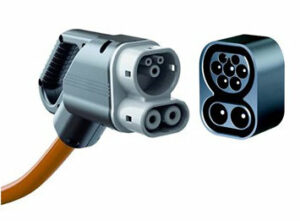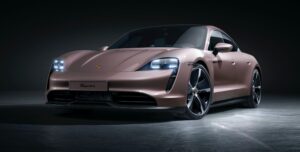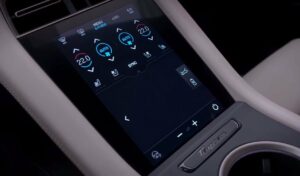Porsche Taycan Turbo S
The Porsche Taycan Turbo S is the most powerful version of the electric Taycan, which is one of the fastest-production sports cars in the company’s lineup. All-wheel drive, instant torque, and superb handling ensure an unforgettable driving experience with the Porsche Taycan.
The Porsche Taycan Turbo S powertrain provides the electric car with a constant 460 kW (625 hp). When combined with Launch Control, the transmission is able to generate a peak output of 560 kW (761 hp) and 1,050 N⋅m of torque. The electric car accelerates to the first hundred in 2.8 seconds and has a top speed of 260 km/h.

The electric car has all-wheel drive and uses the Porsche 4D Chassis Control system, which analyzes and synchronizes the chassis in real time.
Innovative components of the Taycan Turbo S chassis include a three-chamber adaptive air suspension with electronically controlled dampers and an electromechanical body roll stabilization system.
All-wheel drive is provided by two efficient permanent magnet synchronous electric motors, one on each axle. An innovation of the motors is their technological feature that allowed the inclusion of more copper in the stator, the so-called “stud” winding of the stator coils. This innovation, with the same number of components, significantly increased the power output and torque of the power units.

For the electric car, the transmission is the responsible 2-speed gearbox, located on the rear axle. This is an innovative development by Porsche, which provides the Taycan with a huge starting acceleration in the first gear, and offers equally high power reserves in the second gear with a long gear ratio.
The energy recovery system is one of the best in the industry, generating significantly more power at 265 kW than competing systems.

The Porsche Taycan Turbo S is the first electric car in which the system voltage is 800 V instead of 400 V. This innovation serves as the main advantage of the electric car if we talk about its charging because, thanks to this Taycan’s range can be replenished by 100 km in just 5 minutes, using a powerful DC charging station.
It is possible to charge the electric car from 5 to 80% of the battery capacity in 22 minutes using a fast charging station with a peak power of 270 kW. The Porsche Taycan can also be charged in 9 hours to 100% of the battery’s capacity from 11 kW AC power sources.
The Porsche Taycan Turbo S has a range of 412 km on the WLTP cycle with a battery capacity of 93.4 kWh. The charging port of the electric car is located simultaneously in the right and left wings of the car.

The Porsche Taycan Turbo S is a completely new car of the company designed from scratch. It has an original exterior design, but at the same time retains the familiar look inherent in Porsche models.
The original feature of the Taycan, not inherent in other Porsches, which always seemed “trim,” is that in front it looks quite wide and flat with pronounced fenders. The car’s silhouette is delineated by a sporty roofline, which forms a flowing sports car image with the streamlined forms typical of Porsche style. The body design is optimized for the highest aerodynamic performance and makes an important contribution to the car’s high range.

Inside, the Taycan is a completely new Porsche that has moved away from its usual canons of “sporty simplicity”. The interior of the electric car clearly demonstrates the company’s transition to a new era – a clear structure and new interior design architecture.
A distinctive curved dashboard forms the highest point of the Taycan’s torpedo, defining its predominantly informative place in a car in which sport comes first. Further down the torpedo are a 10.9-inch infotainment display and a separate passenger display, both of which are combined in a single black glass panel.

The electric car has virtually no classic controls; everything is digitized and represented by touch buttons. In addition, most of the car’s functions work with voice control.
The Porsche Taycan is the company’s first car to offer interior trim without using leather. Instead, the Taycan uses recycled materials that further emphasize the car’s practicality and sportiness.
| Performance | |
| Acceleration 0 – 100 km/h | 2.8 sec |
| Top Speed | 260 km/h |
| Electric Range | 390 km |
| Total Power | 560 kW (761 PS) |
| Total Torque | 1050 Nm |
| Drive | AWD |
| Battery and Charging | |
| Battery Capacity | 93.4 kWh |
| Battery Useable | 83.7 kWh |
| Europe | |
| Charge Port | Type 2 |
| Port Location | Right Side – Front |
| Port Location 2 | Left Side – Front |
| Charge Power | 11 kW AC |
| Charge Time (0->390 km) | 9 hours |
| Charge Speed | 44 km/h |
| Fastcharge Port | CCS |
| FC Port Location | Right Side – Front |
| FC Port Location 2 | – |
| Fastcharge Power (max) | 262 kW DC |
| Fastcharge Time (39->312 km) | 19 min |
| Fastcharge Speed | 860 km/h |
| Energy Consumption | |
| EVDB Real Range | |
| Range | 390 km |
| Vehicle Consumption | 215 Wh/km |
| CO2 Emissions | 0 g/km |
| Vehicle Fuel Equivalent | 2.4 l/100km |
| WLTP Ratings (TEL) | |
| Range | 416 km |
| Rated Consumption | 243 Wh/km |
| Vehicle Consumption | 201 Wh/km |
| CO2 Emissions | 0 g/km |
| Rated Fuel Equivalent | 2.7 l/100km |
| Vehicle Fuel Equivalent | 2.3 l/100km |
| WLTP Ratings (TEH) | |
| Range | 390 km |
| Rated Consumption | 256 Wh/km |
| Vehicle Consumption | 215 Wh/km |
| CO2 Emissions | 0 g/km |
| Rated Fuel Equivalent | 2.9 l/100km |
| Vehicle Fuel Equivalent | 2.4 l/100km |
| TEL = Test Energy Low | TEH = Test Energy High | |
|
Rated = official figures as published by manufacturer. Rated consumption and fuel equivalency figures include charging losses.
|
|
|
Vehicle = calculated battery energy consumption used by the vehicle for propulsion and on-board systems.
|
|
| Real Energy Consumption between 152 – 294 Wh/km | |
| City – Cold Weather | 217 Wh/km |
| Highway – Cold Weather | 294 Wh/km |
| Combined – Cold Weather | 250 Wh/km |
| City – Mild Weather | 152 Wh/km |
| Highway – Mild Weather | 229 Wh/km |
| Combined – Mild Weather | 188 Wh/km |
| Energy use for each trip will vary considerably depending on the driver and the conditions. Therefore, we have provided a range of estimates which can be useful in developing an understanding of the potential benefits of this technology. | |
| Safety (Euro NCAP) | |
| Adult Occupant | 85% |
| Child Occupant | 83% |
| Rating Year | 2019 |
| Vulnerable Road Users | 70% |
| Safety Assist | 73% |
| Dimensions and Weight | |
| Length | 4963 mm |
| Width | 1966 mm |
| Width with mirrors | 2144 mm |
| Height | 1378 mm |
| Wheelbase | 2900 mm |
| Weight Unladen (EU) | 2370 kg |
| Gross Vehicle Weight (GVWR) | 2870 kg |
| Max. Payload | 575 kg |
| Cargo Volume | 366 L |
| Cargo Volume Max | No Data |
| Cargo Volume Frunk | 84 L |
| Roof Load | 75 kg |
| Tow Hitch Possible | No |
| Towing Weight Unbraked | 0 kg |
| Towing Weight Braked | 0 kg |
| Vertical Load Max | 0 kg |
| Miscellaneous | |
| Seats | 4 people |
| Isofix | Yes, 2 seats |
| Turning Circle | 11.2 m |
| Platform | VW J1 |
| Car Body | Sedan |
| Segment | F – Luxury |
| Roof Rails | No |
| EV Dedicated Platform | Yes |
Home and Destination Charging (0 -> 100%)
A public charging station is required to use the highest possible charging rate. The EVSE/charging station’s charging capacity affects how long it takes to fully charge the battery. The table below shows all possible options for fully charging the Porsche Taycan Turbo S.
In Europe, plugging an electric car into an outlet is often as easy as plugging it into a household outlet, but there are differences from country to country. The table below shows the different ways to charge the Porsche Taycan Turbo S, but in some countries some chargers may not be available.
Type 2 ( IEC 62196)

| Charging Point | Max. Power | Power | Time | Rate |
| Standard 11.0 kW On-Board Charger | ||||
| Wall Plug (2.3 kW) | 230V / 1x10A | 2.3 kW | 43 hours | 9 km/h |
| 1-phase 16A (3.7 kW) | 230V / 1x16A | 3.7 kW | 26h45m | 15 km/h |
| 1-phase 32A (7.4 kW) | 230V / 1x32A | 7.4 kW | 13h30m | 29 km/h |
| 3-phase 16A (11 kW) | 400V / 3x16A | 11 kW | 9 hours | 43 km/h |
| 3-phase 32A (22 kW) | 400V / 3x16A | 11 kW | 9 hours | 43 km/h |
| Optional 22.0kW On-Board Charger | ||||
| Wall Plug (2.3 kW) | 230V / 1x10A | 2.3 kW | 43 hours | 9 km/h |
| 1-phase 16A (3.7 kW) | 230V / 1x16A | 3.7 kW | 26h45m | 15 km/h |
| 1-phase 32A (7.4 kW) | 230V / 1x32A | 7.4 kW | 13h30m | 29 km/h |
| 3-phase 16A (11 kW) | 400V / 3x16A | 11 kW | 9 hours | 43 km/h |
| 3-phase 32A (22 kW) | 400V / 3x32A | 22 kW | 4h30m | 87 km/h |
Fast Charging (10 -> 80%)
If you want to enjoy driving an electric car, one of the most important features to consider is the number of miles per hour the car can travel while charged. This is called the “range” of the car. All electric cars have a certain range, even if they are 100% charged. This is because they do not have an internal combustion engine to lean on if you need to drive a long distance.
Max. Power: The maximum power provided by the charging point
Avg. Power: The average power provided by the charging point during a session of 10% to 80%.
Time: the time it takes to charge from 10% to 80%
Speed: the average charging rate during the session of 10% to 80%
Combined Charging System (CCS Combo 2)
| Charging Point | Max. Power | Avg. Power | Time | Rate |
| CCS (50 kW DC) | 50 kW | 50 kW | 74 min | 220 km/h |
| CCS (175 kW DC) | 166 kW | 157 kW | 24 min | 680 km/h |
| CCS (350 kW DC) | 262 kW | 197 kW | 19 min | 860 km/h |
| Brand | Porsche |
| Model | Taycan Turbo S |
| Body Style | Sedan |
| Car Engine | electric |
| Motor power | 560 |
| Maximum Torque, Nm | 1050 |
| Battery Energy, kWh | 93.4 |
| Power reserve (NEDC/EPA/WLTP), km | - / - / 390 |
| Level Charging (230/400/DC), hours | - / 4.3 / 0.19 |
| Electrical Acceleration, 0-100 km/h (0-62.1 mph) in sec | 2.8 |
| Top Speed, km/h | 260 |

































